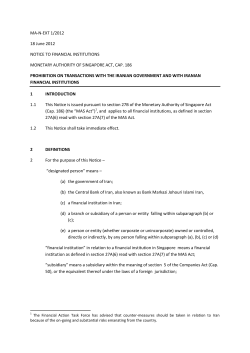
Document 327811
History of free trade zones in Iran Free trade zones (FTZs) in Iran can be traced back to the 1970s when the potential development of Kish Island as a flagship free trade zone in the Persian Gulf was first mooted. After the end of the war with Iraq and with economic reconstruction under way in the late 1980s, the first concrete steps were taken—under the auspices of the First Five-Year Development Plan (1989–93)—to realise this objective. In this first wave, three “Free Trade-Industrial Zones” were announced: Kish and Qeshm (both islands in the Persian Gulf) and Chahbahar. The next decade and a half saw the establishment of three further zones: Aras and Anzali in the north (in the proximity of the CIS states) and Arvand in the south (bordering Iraq and Kuwait). Free Trade Zones (FTZ) and Special Economic Zones (SEZ) The establishment of the FTZs in Iran has been followed up with the creation of 16 “Special Economic Zones” (SEZs). A number of the new SEZs have been given a “special theme” indicating their specific industry or sectoral focus and links (such as petrochemicals, shipping, minerals, energy). The objectives of the FTZs and SEZs are, however, markedly different. The FTZs are more ambitious given that their principal aim has been to attract Foreign Direct Investment (FDI) and ultimately to help generate a diversified industrial base by promoting Iran’s non-oil exports. The SEZs, in contrast, were conceived for improving the supply and distribution networks in the country and act as conduits and channels for goods in transit. Name of FTZ Kish Established Area Location Nearby Countries 1989 91 sq km Persian Gulf GCC states Qeshm 1990 480 sq km Strait of Hormuz GCC states Chahbahar 1991 140 ha South East Aras Anzali 2003 2003 97 sq km 3,200 ha Arvand 2004 173 sq km North West North Caspian Sea South West Pakistan, Oman and other GCC states Azerbaijan, Armenia CIS, Caucasus GCC states International Borders Gulf waterways Gulf waterways Oman sea waterways Nakhchivan Iraq and Kuwait Source: Compiled from Iran’s Centre for Free and Special Economic Zones website: http://www. freezones. ir/. Objectives of FTZs and in particular FTZs in Iran Most free zones are set up with a set of explicit or stated objectives. The most common ones are to attract FDI and to promote manufacturing exports, to create jobs, to upgrade domestic technological capability, managerial skills and know-how, and to regenerate deprived and stressed areas and regions. It is, however, also common for many zones to have some implicit or unstated objectives. The two most common ones are to reduce anti-export bias (while keeping the protective barriers elsewhere in the economy intact) and to act as experimental laboratories for trialling new policies (such as financial, legal and labour policies) before considering their application elsewhere in the economy. In the case of Iran, FTZs have had both a policy and infrastructure rationale combining most of the above goals and objectives. For the Free Trade-Industrial Zones, in particular, the principal stated objective was to help reduce Iran’s isolation from the international economy by promoting both domestic investment and FDI to boost manufacturing exports. FTZs in Iran: A closer look Administrative Set-up Governance matters pertaining to the FTZs are defined by “The Law on the Administration of Free Trade-Industrial Zones.” This law was first passed in 1993 under the auspices of the First Five-Year Development Plan and was subsequently amended in 1999. It comprises 28 Articles and 8 Notes, covering all aspects relating to the operations, management and governance in the zones. Each zone is administered by an Authority organised as a company, with an autonomous legal status, whose capital belongs to the government. Management is through a Board of Directors, which consists of three to five persons appointed by the Board of Ministers. The Managing Director, who is also ex officio Chairman of the Board, is appointed by the President of the Republic from amongst the members of the Board of Directors and is the highest executive authority in the economic affairs and infrastructure of a zone. Business Environment Economic incentives: A wide range of economic incentives are on offer in Iran’s zones to encourage domestic and foreign investment. The most common measures are 15 years’ tax exemption for operators within the FTZs (this does not apply to SEZs), duty exemption for raw materials and machinery imported for production and manufacturing in the zones, no taxes are levied on reexports and exported goods from the zones to the mainland and provision of competitive infrastructure facilities and ancillary services. In addition, a special legal framework and special labour laws have also been adopted to increase the attractions of doing business in the zones. The former aims to offer a streamlined bureaucracy and a set of business friendly rules and regulations for enticing investors, and the latter greater flexibility of employment in the zones. These are discussed briefly below. Legal framework: The “Law on the Administration of Free Trade-Industrial Zones” offers a raft of special rules and regulations designed to attract new enterprises to the FTZs. These include full protection and guarantees offered to foreign investors. For instance, joint ventures are allowed with no limit on investment. Other advantages include: (a) no currency restrictions; (b) 100 percent of capital and profit may be repatriated (to other Iranian free zones or to other countries); (c) non-Iranians can lease land (Iranians can also buy and sell land); (d) business setup and company registration is streamlined and bureaucracy is simplified; (e) foreign nationals do not require visas for entry into the FTZs; (f) special employment and labour regulations apply in the zones Labour laws: Probably the most important factor differentiating the business environment in the zones and the rest of the country concerns their respective labour laws. The labour laws applicable in both FTZs and SEZs, as well as in Iran’s Science and Technology parks, are known as “Regulations of Employment of Human Resources, Insurance and Social Security in the Free Trade -Industrial Zones. Elsewhere and in the rest of the country, Iran’s Labour Code applies. A key difference between Regulations and the Code is that the former has a more flexible approach on terminating employment. In addition, Labour Code establishes much more generous severance payments in case of contract termination. Finally, the Regulations only vaguely cover issues such as occupational safety and health, and provision of training; they do not cover issues relating to workers’ and employers’ organizations, collective bargaining and agreements, or workers’ welfare services. Track Record: A full assessment of Iran’s free zones is hampered by two factors. First, many of the zones are relatively new and therefore lack sufficient history and track record. Second, there is a dearth of evidence relating to the experience of the free zones in Iran. For instance, only the Kish Free Zone Organization publishes some quantitative information on certain aspects of its operations. Tables 1-3 provide data on three key aspects associated with the static benefits for the three principal zones of Kish, Qeshm and Chahbahar for which some data is available: trade and contribution to exports, investment (including FDI) and employment creation. Table 1: Imports and Exports – Iran’s FTZs (1993-2004), US$m Source: “Gozaresh-e Amalkard-e Manategh-e Azad.” Table 2: Domestic and Foreign Investments in Iran FTZs (1993-2004) Source: “Gozaresh-e Amalkard-e Manategh-e Azad.” Table 3: Employment in Iran FTZs (1993-2004) Source: “Gozaresh-e Amalkard-e Manategh-e Azad.” For further specific details about FTZs, you could contact the BICC Member, Goodspeed LLC. Mr Shadab Irvani (LLB), Goodspeed LLC. PO Box 567, Al Khuwair, 133, Muscat, Sultanate of Oman. Mob: 00 968 97079058. www.goodspeedllc.com www.office-zone.net.
© Copyright 2025










